News - United States of America
N is for Nube: Top 5 Must-Have English-Spanish Resources About Clouds
Versión en español: Los 5 mejores recursos en inglés y español sobra las nubes
One of the most exciting features of GLOBE for me is its international aspect. I love learning about other cultures, and I also enjoy studying languages. While learning a new language takes time and practice, I have found that I can pick up new words more easily when I can apply them to a real-world setting. For example, if you teach me the name of a flower, I will likely remember it better if I can see, touch, smell, draw, or do an activity related to that type of flower at the same time. I am originally from Mexico, my native language is Spanish, and I am also a member of the GLOBE Clouds team. And speaking about languages and about learning more easily in real-world settings, did you know that there are many GLOBE Clouds learning resources available both in English and in Spanish? Well, there are! And just like with the flower example, I have found that learning about clouds both in English and in Spanish can be easier if we connect language with experiences. GLOBE encourages learners to make observations of their environment, and it can provide an effective avenue to support language development while engaging in authentic science! I would like to share my Top 5 List of Must-Have English-Spanish Resources About Clouds with you:
-
Cloud Identification Chart (English) / Gráfico para la identificación de nubes (Español): This chart presents photos of the different types of clouds, organized by altitude. Learners can compare what they see in their sky with these photos. Safety first though! Always remind learners to avoid looking directly at the Sun. Now, the names of the clouds can be tricky for English and Spanish speakers alike. These words come from Latin, and they tend to be long! So, the back of the chart also features a cloud type triangle that can help learners remember which prefix corresponds to which altitude. For example, the prefix “alto” is in the middle of the triangle, to indicate that mid-altitude clouds will have the names like “altocumulus” (if they are puffy), or “altostratus” (if they are stretchy). Additional observation tips to determine the sky color and the sky visibility are also included in this fabulous chart. Pro Tip: Laminate your cloud identification charts for longevity!
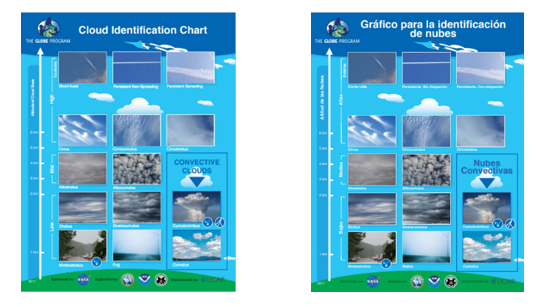
-
Sky Window (English) / Ventana del cielo (Spanish): Remove the card at the center of your sky window, point it towards the sky (always avoiding to look directly at the Sun!), and compare what you see through your sky window with the cloud images around it. This resource is fun and easy to use. Pro Tip: Just like the cloud identification charts, laminating your sky windows will certainly help extend their lifetime!
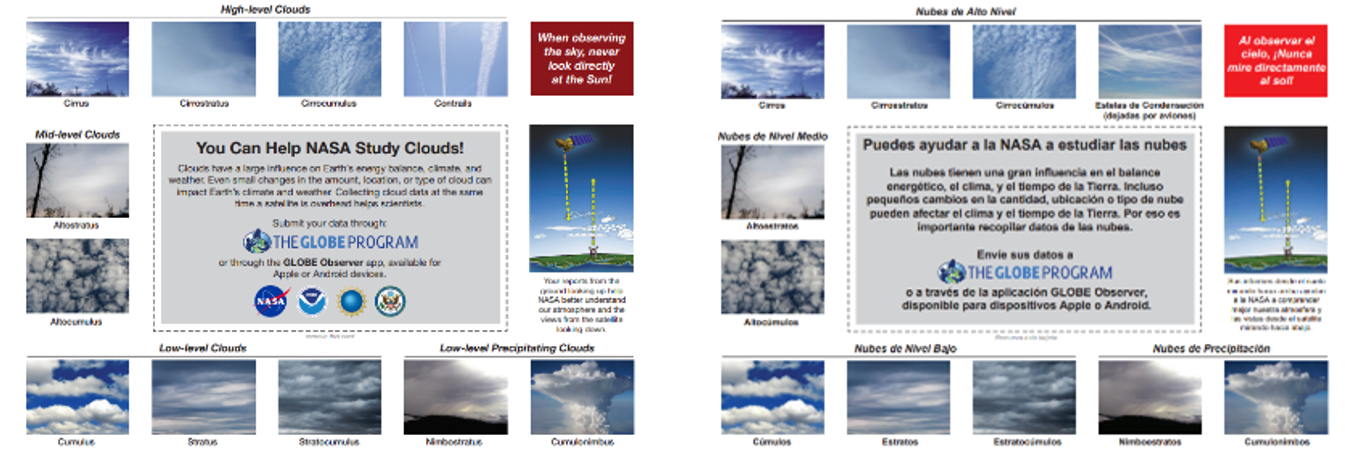
-
Cloud Clues: Visual Opacity (English) / Pistas en las nubes: Opacidad visual (Español): Clouds play a big role regulating how much energy Earth gets from the Sun. Depending on their visual opacity, clouds either reflect or let different amounts of sunlight to pass through them. While the words to describe visual opacity can seem daunting both for English and for Spanish speakers, this activity will help learners add the words “Transparent”, “Translucent”, and “Opaque” to their vocabulary through a hands-on exploration of different materials. Pro Tip: Challenge learners to explain how certain materials may be manipulated to have a different visual opacity (E.g., maybe a cotton ball is opaque, but it becomes translucent if you stretch it; maybe a tissue is translucent, but if becomes opaque if you fold it).

-
Estimating Cloud Cover (English) / Cómo estimar la nubosidad (Español): What percentage of your sky is currently covered by clouds? Unless you have completely clear or completely overcast skies, you may struggle to come up with a precise number. So, while we are not aiming for an exact percentage of cloud cover, we do want to estimate a range. Do you see “Few” clouds (0-10% cloud cover)? “Isolated” clouds (10-25% cloud cover)? “Scattered” clouds (25-50% cloud cover)? Is your sky “Broken” (50-90% cloud cover)? Or is it “Overcast” (90-100% cloud cover)? Even estimating a range may feel difficult in the beginning. On top, some of the words I just used to describe cloud cover can be intimidating at first. Those feelings are normal! This activity helps learners practice both their estimation skills and their new vocabulary in a fun way. Pro Tip: Reverse roles and give learners the opportunity to challenge YOU by having you estimate the percentage of “clouds” they glued to their “sky” on this activity. They will sure love (or at least try) to stump you!
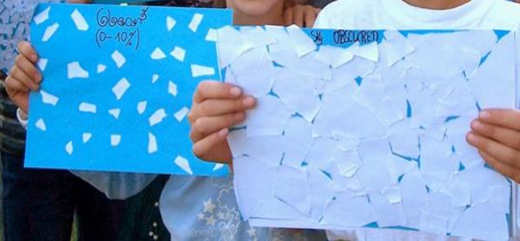
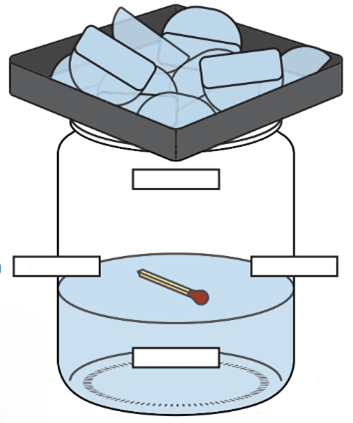
Cloud in a Jar (English) / La nube en un frasco (Español): Wrapping up my top-5 list, I strongly recommend this easy and fun demonstration of how clouds form. All you need is a clear glass jar, a metal tray or plate, ice cubes, and hot water. With these simple materials, your learners can watch a cloud form right before their eyes. Optionally, you can use a match for a more dramatic effect! (Note: just make sure that there is always adult supervision and that everyone follows safety precautions). Learners can then be encouraged to draw what they are seeing and to practice their vocabulary words by labeling the parts of the water cycle. Pro Tip: Before making your cloud, have your learners activate their prior knowledge both of science and of vocabulary. What are clouds made of? In what state is the water in a cloud (solid, liquid, gas)? How are clouds part of the water cycle? Under what circumstances do clouds form?
BONUS: Younger learners and learners of a new language will also benefit from the Elementary GLOBE modules. Each of these modules includes a storybook in which kids explore an aspect of the Earth system using their scientific skills, as well as learning activities that further explore the lesson content and help students develop sound science and engineering approaches to complex problems. One of the modules is (you guessed it) about clouds! You can expect learners to have fun reading or listening to “Do You Know That Clouds Have Names?” and/or its Spanish version ¿Sabías que las nubes tienen nombres? The storybooks and students’ activity sheets are available in English and in Spanish. In fact, some of the storybooks are available in other languages too, including Arabic, French, German and Norwegian.
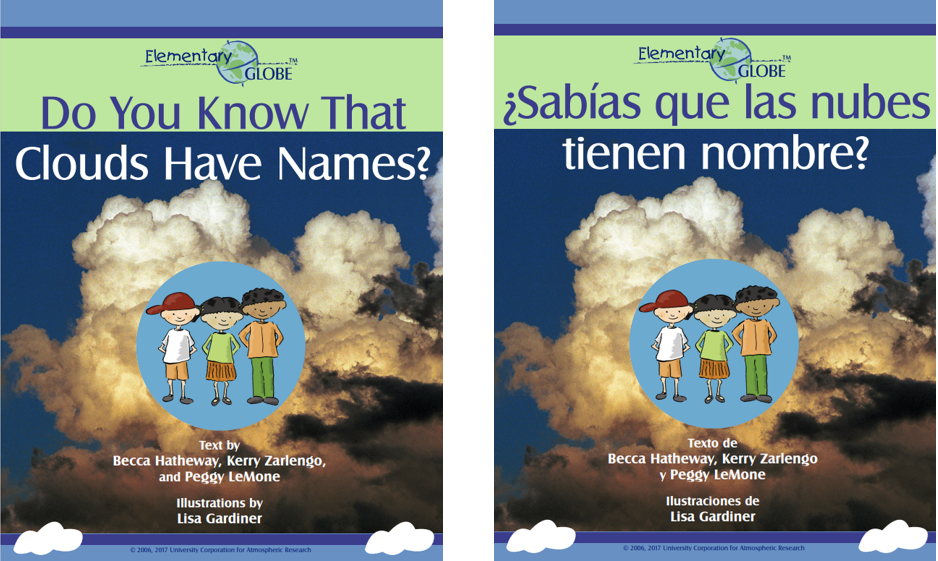
Developing language skills does take time and practice, but it is worth it! Being able to communicate in more than one language is an asset. I hope the list of GLOBE resources I shared can help you engage learners in science, while practicing new vocabulary words in English, in Spanish, or in both languages!
Author: Rosalba Giarratano
News origin: NASA Langley Research Center




